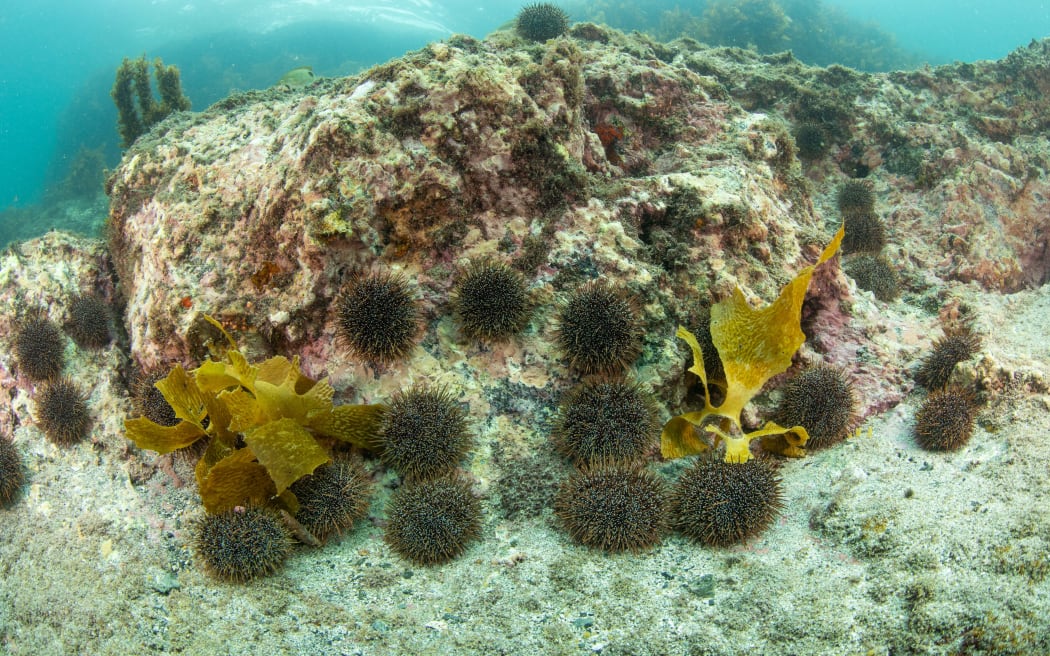Shane Jones sets sights on killer kina – ‘An industrial grade problem’

The underwater wastelands caused by exploding kina numbers will be in the sights of Fisheries Minister Shane Jones at a public meeting in the Far North on Friday.
Jones said the proliferation of kina barrens – areas where the spiny sea creatures ate everything in their path, leaving only bare rock – was one of the top concerns raised with him by coastal communities.
“They grow prolifically, they kill all the kelp, they kill all the seaweed, and they turn the marine environment into a virtual desert. When they get out of control, fish numbers dwindle because they no longer have habitat.”
While kina were regarded as a delicacy in many parts of the country, Jones said once they had stripped an area of food they became “skinny and worthless”.

He said the problem was especially acute around Northland and Coromandel, but barrens had also been reported in South Island waters.
The public meeting will be held at the Awanui Hotel, on State Highway 1 about 10km north of Kaitāia, from 9-11am tomorrow.
Jones said options he would talk through at the meeting included changing bag limits and the permit system, so people could tackle the problem themselves in their own backyards.
“It’s an industrial grade problem and I’m not suggesting the tools I have will necessarily eradicate the kina barren plague, but coastal communities want practical responses and that’s what I’m in the business of delivering,” he said.
“I also want to hear from men and women who probably go in the water more often than I do, about other practical remedies that my officials should be pursuing.”

Some coastal communities might want to relocate kina and try to grow them elsewhere, because they were sought after as food not just in New Zealand but internationally as well.
Jones said the cause of kina barrens was debatable.
“Some ecologists say it’s related to overfishing but the evidence is not conclusive in that regard. From my perspective as Fisheries Minister, I can provide some practical tools through the law, to allow local communities to go and cull them.”
He said previous ministers had promised action but had been distracted by other priorities.
In northern waters the long-spined sea urchin, a subtropical relative of the kina, was an even more voracious feeder that was found at much greater depths.
Actions already underway aiming to reduce kina barrens in Northland include a two-year fisheries closure and fishing method prohibition at Tūtūkākā Harbour, Ngunguru Bay, Ngunguru River and Horahora River.
It was hoped the fishing restrictions would increase the number of rock lobsters, or crayfish, in the area.
Rock lobsters are key predators of kina.
A mapping programme is also underway to better understand the extent of kina barrens.
Whangārei marine ecologist Vince Kerr said barrens created by various species of sea urchins, such as kina in New Zealand, occurred in temperate waters worldwide.
He said the removal of reef predators led to the increase in sea urchin numbers.
In Northern California the fur trade led to the demise of otters, a highly efficient predator, and an explosion in the sea urchin population.
In New Zealand it was the removal of large crayfish and snapper.
“There is very clear evidence that it’s the result of over-fishing,” he said.
The good news was that once large reef predators were protected, such as in the marine reserves at Tāwharanui and Leigh, kina numbers declined and kelp forests returned.
Kerr said kelp forests were among the most productive ecosystems on Earth – on a par with coral reefs and tropical rainforests – and acted as nurseries for many of New Zealand’s most popular commercial and recreational fish species.
Consultation on government proposals to increase the recreational bag limit for kina, and the introduction of a new special permit for kina removal or culling, have been extended until 20 May.
According to the news on Radio New Zealand




